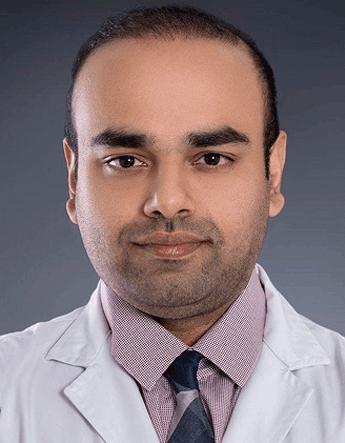Thyroid Artery Embolization for Nodules
Thyroid nodules are abnormal lumps or growths that form within the thyroid gland in your neck. While most are benign, some can grow large enough to cause discomfort, compress nearby structures, or raise concern for malignancy. Thyroid Artery Embolization is a cutting-edge, non-surgical procedure performed by expert interventional radiologists . It works by reducing the blood flow to the problematic part of the thyroid gland, prompting it to shrink naturally over time without disrupting the healthy portion of your thyroid. Thyroid Artery Embolization (TAE) offers a non-surgical, image-guided alternative to shrink the thyroid gland safely.
Understanding TAE
Who Is a Candidate for Thyroid Artery Embolization (TAE)?
TAE is recommended for patients with:
Large Benign Nodules Causing Symptoms
Such as neck swelling, discomfort, difficulty swallowing, or breathing issues.
Multinodular Nodules
Especially when multiple nodules are enlarging but are confirmed benign through prior testing.
Patients Unfit for Surgery
Individuals who are at higher surgical risk due to age, heart conditions, lung problems, or other medical reasons.
Patients Who Prefer Non-Surgical Treatment
Those looking to avoid scars, general anesthesia, and longer recovery times associated with thyroid surgery.
Preserving Thyroid Function
In cases where maintaining as much natural thyroid hormone production as possible is important.
How Is TAE Performed?
Preparation
- Local and topical anesthesia is applied to numb the skin.
- A mild sedative is given to ensure the patient remains relaxed and comfortable.
During the Procedure:
- The physician inserts the catheter through a small puncture in the groin or wrist.
- Imaging is used to guide the catheter to the thyroid arteries.
- Tiny embolization particles are released into 1–3 thyroid arteries, blocking blood supply to the nodular tissue.
- The rest of the thyroid remains intact and functional.
After the Procedure:
- There is no hospital stay required.
- Patients go home with only a small Band-Aid at the catheter site.
- Normal activities can usually be resumed within 1–2 days.
Advantages of TAE Over Traditional Surgery
In cases where maintaining as much natural thyroid hormone production as possible is important.
Advantages of TAE Over Traditional Surgery
No major incision, no stitches, no scarring
Preserves healthy thyroid function
Outpatient procedure with faster recovery
Performed under local anesthesia — no general anesthesia required
Less risk of surgical complications
Why choose RIVEA for thyroid nodule treatment?
At RIVEA Vascular Institute, you’re treated by one of India’s leading experts in minimally invasive interventions. At RIVEA Vascular Institute, we prioritize precision, safety, and patient comfort. Our thyroid embolization program is led by specialists trained in advanced image-guided techniques that eliminate the need for surgery.
At RIVEA you avail:
- Advanced imaging technology for precision targeting
- Personalized consultation and care plans
- Faster access to treatment, no long waits
- Outpatient convenience with high safety standards
FAQs
What Are Thyroid Nodules?
A thyroid nodule is a lump that can develop within the thyroid gland, often discovered during routine exams or imaging. In most cases, nodules are non-cancerous and don’t require immediate intervention. However, if a nodule is large, growing, causing pressure symptoms, or cosmetically concerning, treatment is recommended.
What is Thyroid Artery Embolization?
It’s a minimally invasive procedure that blocks blood flow to the overgrown or overactive portion of the thyroid, allowing it to shrink while preserving the rest of the gland.
How does it compare with RFA (Radiofrequency Ablation)?
Both are non-surgical. Embolization is ideal for larger goiters or multiple nodules and is performed without heat. RFA is more suited to small, solid, isolated nodules and uses thermal energy. RFA may not be suitable for deeply located nodules or those near sensitive structures.
Is the embolization procedure painful?
It’s done under local anesthesia with light sedation. Patients typically experience little to no pain during the procedure.
Will I still need thyroid medications afterward?
In most cases, no. The healthy thyroid tissue continues to function normally.
How long does the procedure take?
Between 45 and 90 minutes, followed by 2–4 hours of post-procedure monitoring.
Is this a permanent solution?
In many cases, yes. Some patients may require a second embolization session if new nodules develop.
Can multinodular goiters be treated with embolization?
Yes. Embolization can target multiple nodules in one session, especially in diffuse or large goiters.
Is embolization safer than surgery?
For eligible patients, it poses fewer risks, requires no general anesthesia, avoids vocal cord injury, and leaves no scars.
Our Team
-

Dr. Arjun Reddy
MBBS, MD
Chief Interventional RadiologistDr. Arjun Reddy is a highly accomplished Interventional Radiologist with extensive international training and a track record of pioneering minimally invasive, image-guided procedures in India.
View Profile Book an Appointment


